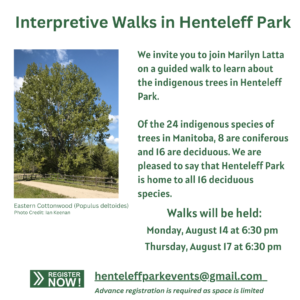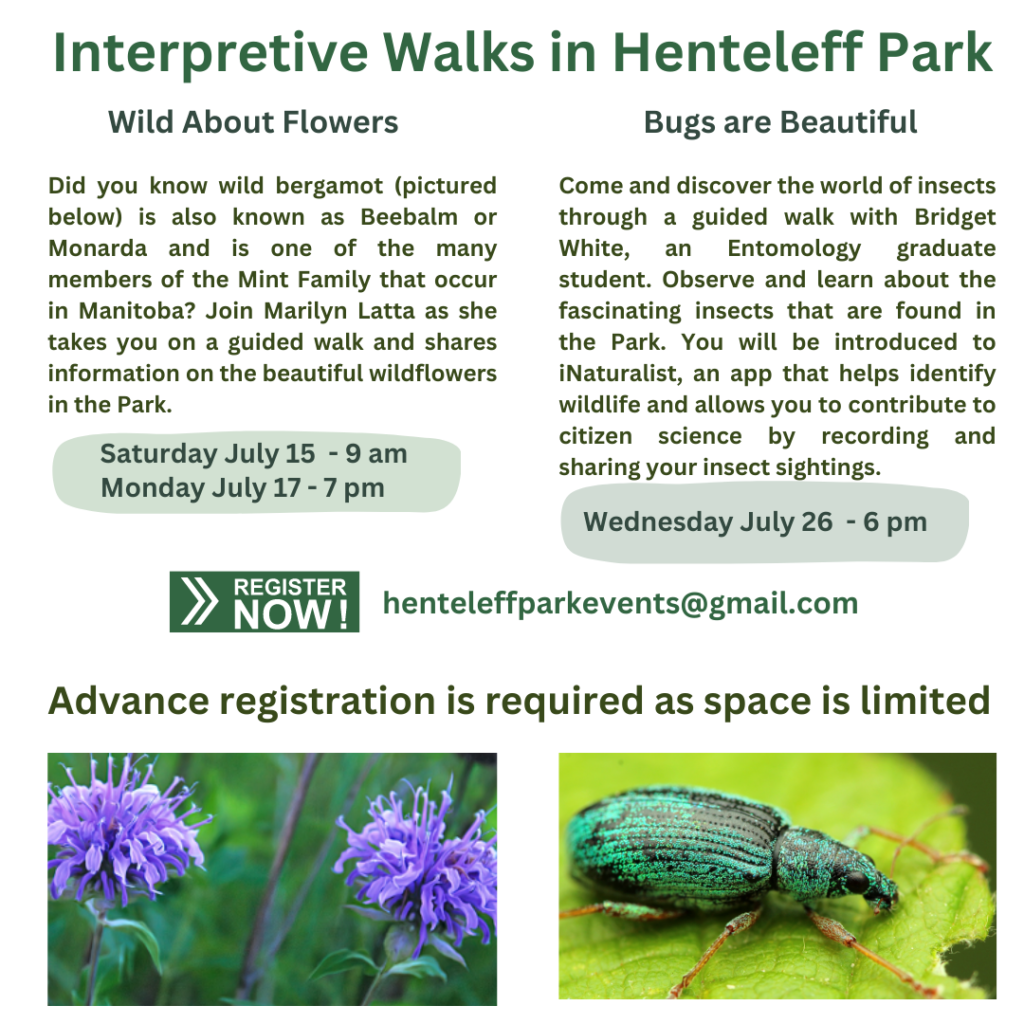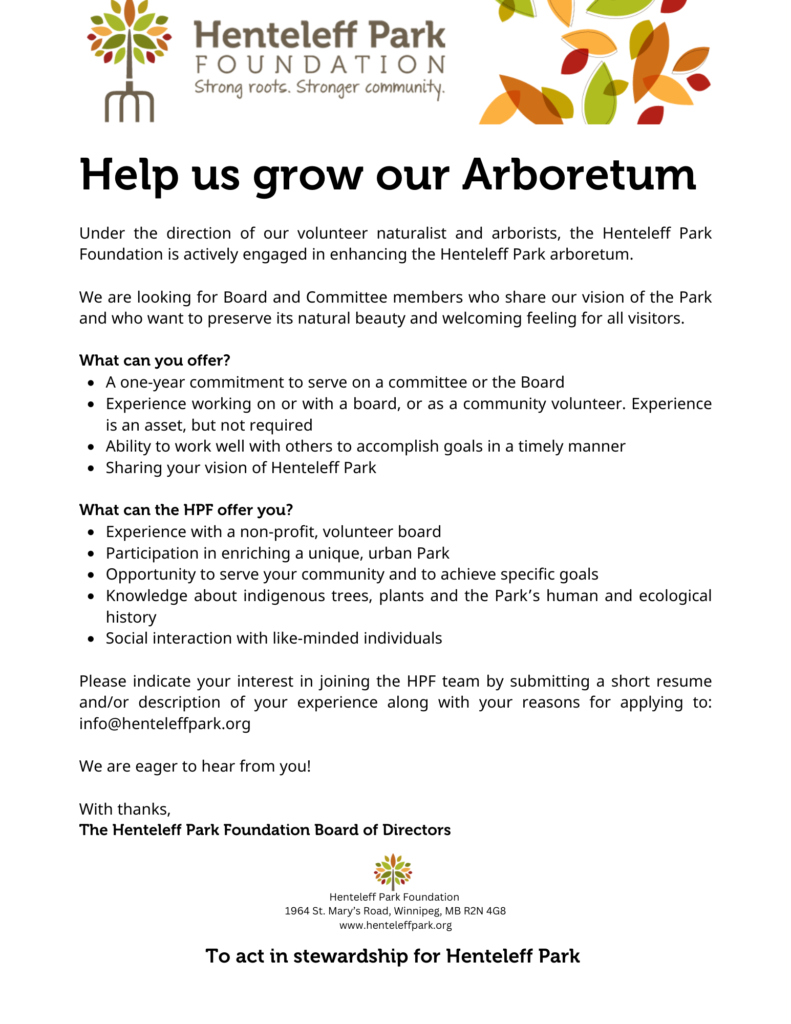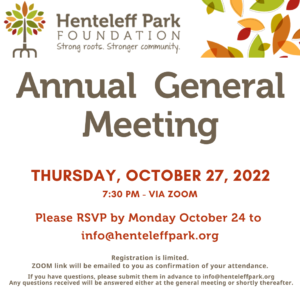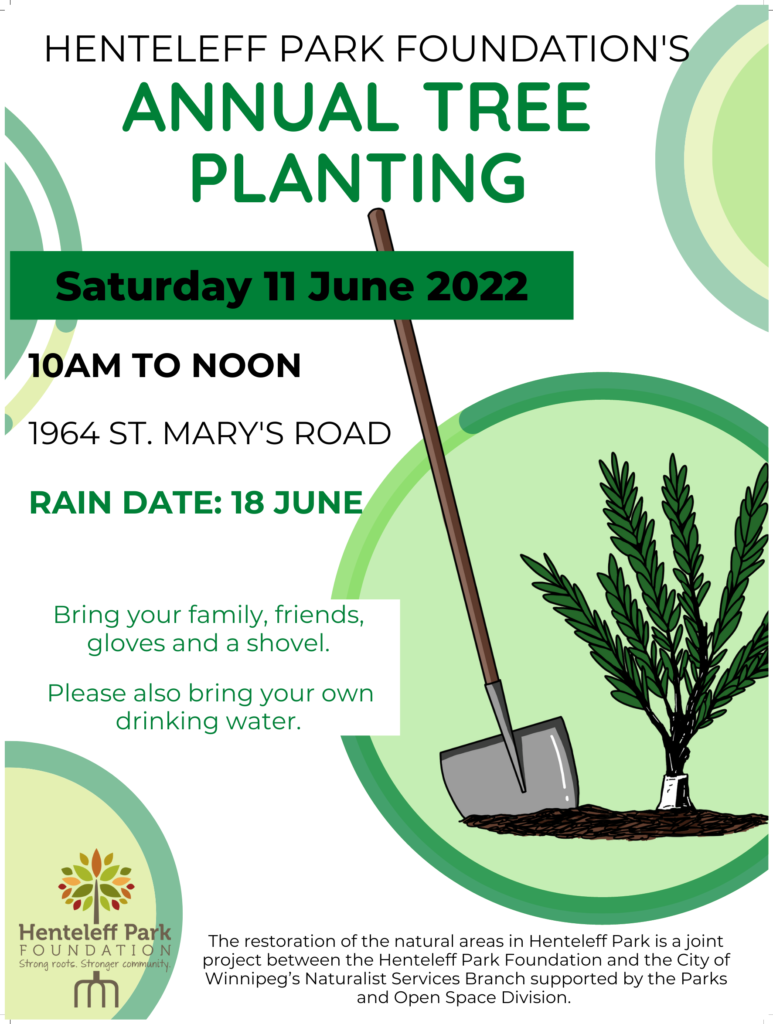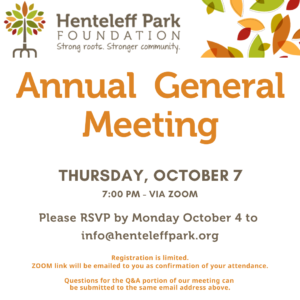Archive for Events
20th Annual Tree Planting
2024 Spring Newsletter
Celebrating 20 years of tree planting

Photo: Wes Braun
Greetings from the Board President
Spring has always been my time for reflection and renewal. As I look in the rear-view mirror and reflect on the long-term goals of Henteleff Park I am encouraged by our successes in 2023. As I look ahead at what will be new in the park for 2024, I feel a sense of excitement and anticipation.
Last year many of our activities focused on planning. This year will be different! At our 20th anniversary celebration of our annual tree planting event that takes place Saturday, June 8, 10 a.m. to noon, we will formally embark on two new initiatives: the food forest project and the arboretum project.
Special thanks to the members of the Site Management Committee, under the leadership of Marilyn Latta, for their dedication and commitment to these projects. All committee members spent many long hours on the design of these projects which are detailed in this newsletter.
I also want to acknowledge the valuable contributions of Nicole Reenders and Nik Friesen-Hughes who expressed their passion for the park through sharing their expertise. Nicole Reenders worked tirelessly on the landscape design of the food forest; I lost count on the number of drawings she produced in the planning of the site. Nik Friesen-Hughes shared his expertise to develop the conceptual design document for the arboretum. Their contributions play an important role in enhancing the park’s educational value in the community.
An important reality for community boards is being able to maintain energy through changing membership. As we begin ‘dusting off’ equipment for the seasonal startup of the park’s activities, we welcome new members to our board and committees and acknowledge the valuable contributions of long-standing members who have resigned for various reasons. I am happy to report our board is becoming more diverse in gender, ethnicity and age; which more closely reflects our community.
Looking back on 2023, our collective success was due to many individuals who put in countless hours serving on the board and who continuously shared their knowledge and expertise. I want to thank our volunteers who put in many hours weeding and cleaning the park for all to enjoy. With the help of many public donors and our resolute board and committee members, it looks like another exciting year for the park’s many visitors.
A special thank you to all our sponsors who are making 2024 such a special year. I want to thank the following for their financial support:
- Canada Summer Jobs program
- City of Winnipeg
- TD Friends of the Environment Foundation
- Tree Canada [Manitoba Lotteries sponsor]
- Urban/Hometown Green Team Program [Province of Manitoba]
Stay tuned to learn about our plan to enhance the Henteleff Park experience and how you can participate in the planned activities over the summer season starting with the 20th anniversary celebration of tree planting on June 8th.
John Borody
President, Henteleff Park Foundation

Community tree plantings enhance Henteleff Park
This year Henteleff Park celebrates its 20th anniversary of community tree planting events.
These community tree plantings enhance and protect the existing landscape and ecosystems in this urban oasis nestled along the eastern banks of the Red River in St. Vital.
The park’s interpretative centre located at the park’s entrance help visitors explore and appreciate the history and significance of this land that once nurtured early Métis culture, Métis and other families involved in foundation of the Market Gardeners’ Society formed in 1903 and the Henteleff family’s market garden.
The City of Winnipeg expropriated all but five acres in 1967 to create a riverside “green belt”. This project was eventually abandoned and the land was turned into the City of Winnipeg tree nursery. At that time most of the land had been cleared except for a fringe of trees along the river and Normand Creek and a remnant river bottom forest at the south-west end of the property. Evidence of the tree nursery operation can be seen today in the many straight rows of trees found in the park.

Photo: (1960’s)

Photo: Angela McBride (2007)
Beginning in 1996, an organization—The Friends of Henteleff Park—entered into negotiations with the City of Winnipeg that led in 2002 to the rezoning and designation of the land as Henteleff Park. Though the land remains city-owned, the Henteleff Park Foundation works cooperatively with the City of Winnipeg to care for the park.
One of the first projects undertaken by the Henteleff Park Foundation was to restore the riparian habitat along the river and creek banks, which helps to stabilize the banks as well as provide habitat and migration corridors for wildlife.
When the tree nursery operation vacated the park in 2007, the focus switched to plantings along the south boundary of the park to help screen park users from the new Van Hull development.

At the community tree planting in 2008 volunteers planted trees as a privacy screen from the new Van Hull development.
Photo: Marilyn Latta (2008)
Since then, a number of volunteer tree plantings have been held along that side of the park. Things looked a little sparse in the beginning, but over the years the area has started to fill in nicely.

In 2010, a grant from the Wal-Mart Evergreen Green Grants Program provided funds for planting fruit trees and shrubs along the south trail as well as an interpretive sign.
Photo: Marilyn Latta (2010)

By 2020, the plantings behind the interpretive sign created an attractive border for a nature trail.
Photo: Marilyn Latta (2020)

The diversity of shrubs provides nectar and pollen for insects, nesting cover, berries for birds and other wildlife and a visually appealing landscape for humans. A great benefit all the way around!
Photo: Justin Huang (2022)
Community tree plantings also take place in other areas of the park to compensate for the loss of trees due to their age or Dutch Elm disease. This is done along the river banks or in the remnant forest at the back of the park to try and maintain the tree cover. Once the shade from the tree canopy is lost, weedy species quickly move in and prevent natural regeneration from occurring.
Over the years, more than 10,000 native trees and shrubs have been planted in the park. However, planting trees is only the first step as they require watering for a year or two to help them get established, and protection from deer. Weeding is also an important component of care as non-native invasive species such as Canada thistle, Burdock and Tufted vetch can easily outcompete small trees and shrubs. It usually takes from five to 10 years of care before the plantings fill in enough that the need for weeding lessens, although some weeding will always be required.
Marilyn Latta
HPF Director & Chair, Site Management Committee

New plantings to mark beginning of food forest
The Henteleff Park Foundation Board is proud to announce that thanks to the generous support of several community partners, we have secured funding and resources to move the long-awaited food forest project forward.Development of the food forest project in our 20-hectare (50-acre) park along the Red River in St. Vital got underway in May with constructing trails within the footprint of the 0.3-hectare (0.74-acre) food forest.
In celebration of the new food forest, an exciting event is being planned for the 20th anniversary tree planting, June 8, 10 a.m. to noon. We plan to plant approximately 150 fruit and nut producing trees and shrubs that will show-case the extensive variety of hardy fruit-bearing species suitable to hardiness zone 3a.
During the next two to three years, all planning, development and maintenance of the site will be carried out by board and committee members, staff and volunteers. As the site matures, there will be opportunities for community involvement.
What is a food forest?
A food forest is best described as an ecosystem created through human intervention to mimic a low-density forest capable of supporting the needs of humans, plants, beneficial insects, microbes and wildlife habitat. Similar to natural forests, a food forest is composed of trees, shrubs, herbaceous plants, ground cover, vines and root fungi, but unlike the closed canopy of a natural forest, a food forest features sunlight and limited shade.
A food forest has seven layers: an upper canopy layer, lower canopy layer, shrub layer, herbaceous layer, groundcover, mycorrhizal/fungi layer and a vine layer, all of which are intended to produce food and provide habitat. A food forest takes a number of years to establish, but eventually will be resilient enough to function on its own with limited maintenance.

Pollinating insects, like this brown-belted bumble bee, play a vital role in a food forest.
Photo: Wes Braun
The practice of cultivating various forms of food forests is thousands of years old. In the 1960’s, Englishman Robert Hart observed the degradation occurring to the natural world, particularly with respect to farming practices. He observed the benefits that could be gained when forests were shaped to become highly productive food sources. He demonstrated that growing food in a forest setting allowed edible fruits, nuts, herbs, plant greens and vegetables to grow together in a harmonious arrangement.
Hart’s approach combined the production of a self-sustaining perennial system without the use of external fertilizers. Unlike the traditional method of growing crops in rows, food forests are three-dimensional, enabling them to generate an abundance of food in addition to being capable of providing biodiversity, efficiency and sustainability.

Wild plum blossoms in the park.
Photo: Wes Braun
Other benefits are water retention, carbon sequestration, weed suppression, greater ability for pollination, pest-management, nitrogen fixing and improved soil benefits. Once established a food forest can address issues of food insecurity and food literacy and provide continuous availability of fresh and nutritious food in summer and fall. It is also a space to promote and encourage community and student engagement, volunteer opportunities and environmental education.
From an environmental perspective, once established, the food forest will sequester carbon, protect and restore the soil, increase biodiversity and habitat, conserve water and reduce rainwater run-off.
Doug Drobot and Liz Sellors
HPF Directors & Site Management Committee Members

Henteleff Park’s arboretum is going digital
An arboretum is a place where trees, shrubs and sometimes herbaceous plants are cultivated for scientific and educational purposes.Henteleff Park Foundation is renting space on the plantsoon platform to virtually house the park’s arboretum because the park’s current website cannot accommodate this project.The first collection that will be showcased are the native trees. The park is now home to all 16 specious of deciduous trees indigenous to Manitoba and two of the eight coniferous species.

Specimen trees in the park will be marked with signs that include the English, French, and Latin names of each tree and a QR code. This code will take users to a page on the plantsoon website where they will find information about the tree species and photographs showing features such as an overall view, bark, leaves, flowers and/or fruit of that tree.The site will also include a map showing the location of all marked specimen trees in the park. This map will be available in a downloadable form on the Henteleff Park website along with the general link to the plantsoon site.It will likely be the end of summer before the park’s Indigenous Tree Collection website is fully operational. Future collections are planned to provide information on wildflowers, native shrubs and the food forest so stay tuned!Marilyn Latta
HPF Director & Chair, Site Management Committee

Henteleff Park has gotten bigger
Did you know that Henteleff Park is now a 20-hectare (50-acre) park. An additional four hectares (10 acres) of land at the west end, was officially transferred to the park by the City of Winnipeg in December, 2023. The large field, with many patches of milkweed and open views of the river, will be left largely as it is now, although several benches and interpretive signs will be added for the benefit of park users.

Volunteer opportunities for all ages
Volunteering at Henteleff Park is a rewarding experience for people of all ages. If you have volunteered before, welcome back to another season. If you haven’t volunteered before, we would love to have you join us.
Volunteers make Henteleff Park possible. Both regular and casual volunteers contribute by removing invasive plants, maintaining the grounds, planning and achieving large projects. Every contribution is important to our mission of providing stewardship for Henteleff Park. The park has a range of flexible volunteer opportunities for individuals, families and students. Enthusiasm and a willingness to learn are the only requirements.
Wednesday mornings 8:30 a.m. to 10:30 a.m.
Thursday evenings 6:30 p.m. to 8:30 p.m.
Work with a group of volunteers with instruction and supervision. Choose the times that work for you. Groups will do a variety of tasks including removing invasive plants, maintaining the interpretive centre area and watering new plants. This is a great opportunity to work outside, learn about the flora and fauna of the park and meet new people. High school students are welcome to join this group.
Volunteer at your own pace
Learn the history of the park and how to identify, remove and dispose of invasive plants during a 1.5-hour orientation. After completing orientation, you can work in the park when you wish for as long as you like. You can select a particular area of the park to focus on and watch it grow throughout the season. This is a great option for individuals and families that want to work together.
Prairie Pals
This is a group of experienced gardeners who remove weeds from our 0.6-hectare (1.5-acre) tall grass prairie restoration. The prairie is a delicate habitat and good knowledge of gardening and weed identification is essential. Orientation is provided. Prairie Pals volunteer once or twice per week at a time that is convenient for them.
Team building opportunities
Looking for a team building event? Groups tour the area, learning about the history, plants and animals of Henteleff Park. The two-hour session can include planting, watering or focusing on invasive plant removal. Last year some groups returned the next week because they enjoyed it so much!
Contact terri.ashcroft@henteleffpark.org for information about volunteering at Henteleff Park.
Terri Ashcroft
HPF Director & Volunteer Coordinator

These enthusiastic volunteers are among the many volunteers who helped control the weeds in Henteleff Park in 2023.
Photo: Terri Ashcroft
HOW TO DONATE TO HENTELEFF PARK FOUNDATION
Did you know that Henteleff Park is owned by the City of Winnipeg and managed by the Henteleff Park Foundation? Our non-profit, volunteer run registered charity employs summer students, plants trees and shrubs, maintains trails and provides interpretive programs. We rely on grants and individual donations to help us fulfill our mission of providing stewardship for Henteleff Park.
Donations can be made to Henteleff Park Foundation through the CanadaHelps website or by using this QR Code.

1964 St. Mary’s Road
Winnipeg, MB R2N 4G8
Betty Parry, Vice-Chair
Huong Giang Nguyen, Treasurer
Corinne Caron, Outgoing Secretary
Simran Bkral, Incoming Secretary
Terri Ashcroft, Director
Roddy Adjei, Director
Owen Clune, Director
Doug Drobot, Director
Les Janzen, Director
Marilyn Latta, Director
Joel Wortley, Director
Elizabeth Sellors, Director
Anjen McLean, Director
Yude Henteleff, President EmeritusA special thank you to the outgoing Board members for their commitment and dedicated service: Laura Meade, Sheila Pursey and Karen Ilchena.
Interpretive Walk – August
Interpretive Walks
Join us for a walk!
Register : henteleffparkevents@gmail.com
Advance registration is required as space is limited.
Annual General Meeting
Henteleff Park Fall Fest
FALL FEST 2018
Henteleff Park
1964 St Mary’s Road

To One and All!
Henteleff Park Foundation will be holding its
first annual Fall Fest at Henteleff Park.
There will be music, snacks and a few words from
Henteleff Park folks and friends,
followed by a tour through the park with
Master Gardner, Marilyn Latta at 12:00 noon
Come and join us for a morning out at Henteleff Park!
Copyright © 2012 - 2025 All Rights Reserved :: Reg. Charity #864179957RR0001


